Sherrie Flick's Blog, page 2
January 16, 2012
Conquering Winter Vegetables: Parsnip, Turnip, Cabbage
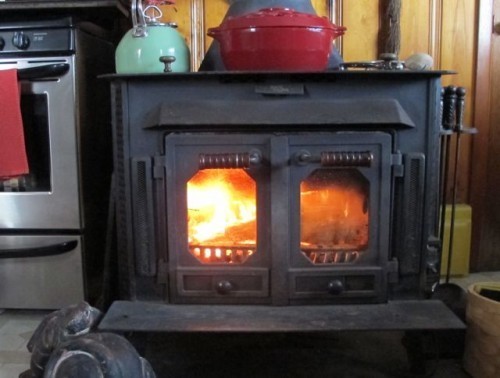
The fire roars in the wood-burning stove as the first real snowstorm of 2012 begins. I'm settled into my chair, thinking about parsnips. I'm thinking (in all honesty) about how I don't like them.
I eat most things non-meat, it's true. But each year I manage to carefully avoid a few root vegetables. As I unpacked this past week's CSA box and nestled its contents into the fridge, I knew I had some cooking thinking to do.
I've been reading through Didi Emmons' new book Wild Flavors, and I've trusted her recipes for quite some time from Entertaining for a Veggie Planet. I figured if anyone could get me to like the parsnip, it was her. And there it was on p. 24: Vegan Parsnip and Wild Mushroom Pie. Here, parsnips are combined with (and slightly diluted by) potatoes in a garlicky mash, nestled above some nicely sautéed mushrooms and topped with a good amount of tangy caramelized onions—all with the crunch of 100% whole wheat crust. (A little time consuming to make, but worth it.)
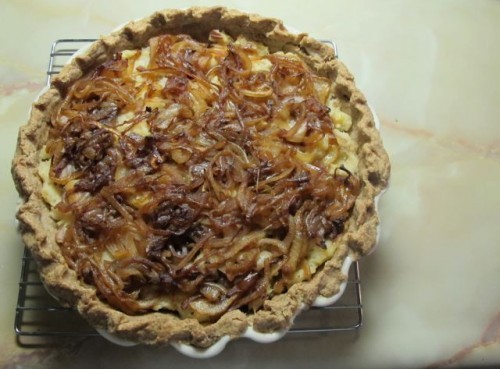
A parsnip win. Textured and tasty, the pie kept well for easily transportable leftovers. Parsnips down. Turnips and cabbage to go.
I faced the three white turnips head-on with Puree of Turnip soup. Drizzled with a little rosemary-arugula oil that I had leftover from a successful Brussels Sprouts experiment, the soup looked elegant but packed a nice hardiness. The turnips are sauteed in butter with a white wine reduction and then spiced simply with freshly ground white peppercorns and sea salt.

With a hunk of whole-grain bread, the soup made an excellent lunch, and then with a lightly dressed arugula salad—a great dinner.
With the big head of cabbage, my husband Rick chipped in and made a slow-cooker cabbage soup with cannellini beans and lots of oily onions. Once again, the contrasting textures really interested me.
But Rick's soup didn't do-in the full head of cabbage, and so I decided to try a recipe recommendation from my old housemate, Christopher–cabbage juice. Specifically, cabbage (4 c.), avocado, parsley (handful), and a granny smith apple juice.
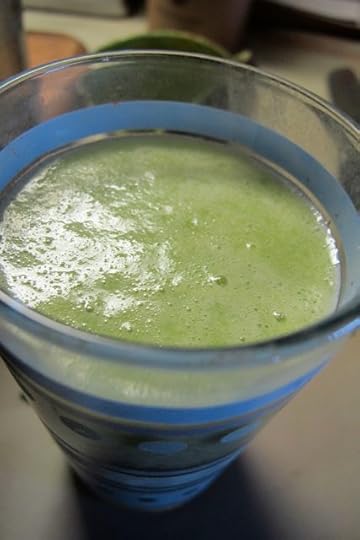
A juice revelation. Refreshing with a creamy, interesting sweetness and a truly lovely shade of green that helped to combat Pittsburgh's winter gray skies.
The Winter CSA not only keeps me in touch with what is local right now in Western Pennsylvania, but also creates a kind of kitchen improvisation every other week where I'm given mystery vegetables that I both love and don't—and then forced to marry them in recipes. A really great challenge for a seasoned cook and baker or anyone interested in learning more about food, one box at a time.
Recipe
1 lb white turnips, cut into 1/2 in. chunks
1 medium onion, chopped
2 garlic cloves, smashed
2 Tbls Sweet butter
Dash of olive oil
1 Medium potato, cut into 1/4 in. chunks
1/2 c. Dry white wine
3-4 c. Vegetable stock
White peppercorns, freshly ground
Sea salt
Melt the butter and dash of olive oil in a big soup pot over medium heat. Add the onions and turnips and saute for 5 minutes or until the onions are translucent. Add the white wine, bring to a boil, and then simmer until half-reduced, about 3 minutes. Add the stock and the potatoes, bring to a boil and simmer 15-2o minutes until the potato is not crunchy, but not mushy.
Remove from heat and puree in a blender or food processor. Return to pot, season, and simmer for 5 more minutes–adding more stock or water to reach the consistency you'd like.
The drizzle:
1/2 c. Extra virgin olive oil
3 Tbls. fresh rosemary, roughly chopped
Handful Arugula, roughly chopped
1/4 c. Fresh parsley, chopped
1 Garlic clove, smashed
1/4 + tsp salt
Freshly ground black pepper, to taste
Combine everything in a food processor until the mix leans toward a vibrant shade of green. (This drizzle is great as salad dressing or on anything, really.)
December 28, 2011
Grilled Cheese Improvisation: Roasted Beets with Cambozola Bleu
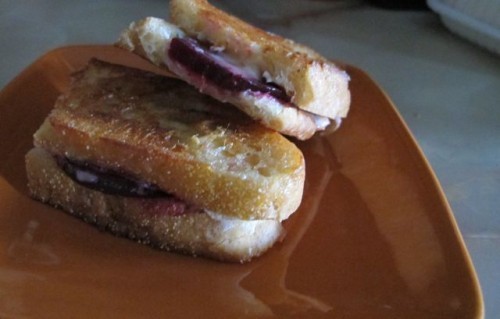
My recent exceptional improvisational lunch was due, in part, to our new Winter CSA from Kretschmann Organic Farms, located in Rochester, Pa.
The thing about a CSA is that it encourages you to eat vegetables in different quantities than you might choose otherwise. This is how I came to have an extraordinary amount of roasted beets in my refrigerator. Beets are great. They're pretty and nutritious and tasty. And so this afternoon I thought: Hmmm… Grilled cheese?
Over the holidays my husband Rick had purchased a variety of cheeses at our beloved cheese counter, Pennsylvania Macaroni in Pittsburgh's Strip District–one being the amazing Cambozola Bleu. This isn't an in-your-face stinky bleu, but more of a tap you on the shoulder and nudge you a little so you move over in your seat kind of cheese. It's good, I mean. Especially good…that's right…with beets.
I sliced up some ciabatta bread, added thinly sliced bleu topped with a layer of thinly sliced beets. Colorful and crunchy with a tiny attitude.
December 18, 2011
Cookie Exchange: Cashew Shortbread
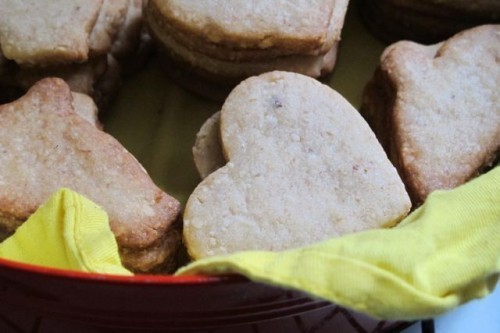
Once a month I get together with friends to eat and play music. We call it Hoot Night. Johnny Cash, Hank Williams, Gillian Welch–I'm learning to play the ukelele. This month we decided to make our get-together a hoot-potluck-cookie exchange.
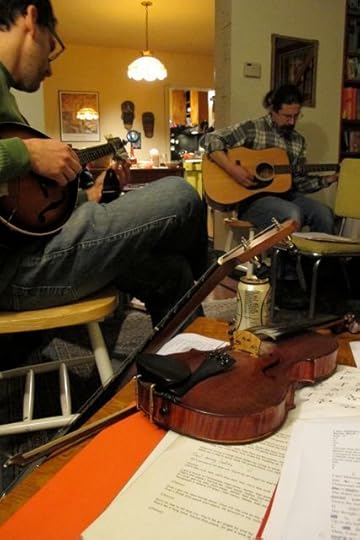
The cookie exchange concept is really efficient. Everyone makes one batch of cookies (about 3-4 dozen), brings them to the party, and then they're divvied up into appealing sampler plates. Each person heads home with a nice variety of treats. It's a great way to taste new recipes and get baking ideas from your friends.
I decided to bake one of my go-to recipes: Cashew Shortbread from Mollie Katzen's The Enchanted Broccoli Forest. It's easy. The cookies are delicious and shapely and buttery, like you dream about.
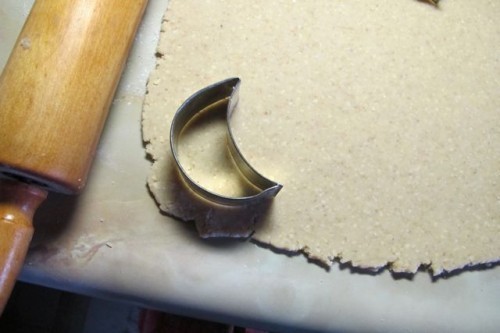
In all, we had some beautiful Mandelbrodt, peanut butter cookies, savory Stilton-Walnut crackers, and Stollen. We learned how to play "Jinglebell Rock," "Blue Christmas," and "I Saw Mommy Kissing Santa Claus." We ate butternut squash soup, bread, and salad along with a fine pitcher of celebratory Manhattans.
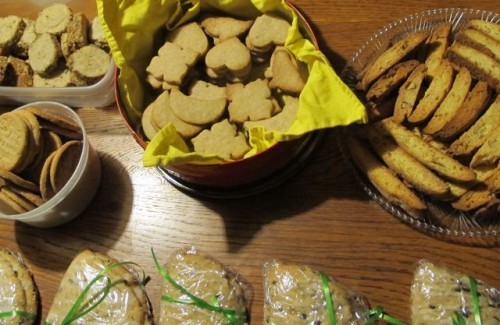
Ho, ho, ho.
Recipe:
Cashew Shortbread
1 c. Unsalted butter
1/2 c. Brown sugar, packed
1 c. Cashews, finely chopped in a food processor
2 c. Flour
1/4 tsp. Sea salt
1/2 tsp. Baking powder
Preheat the oven to 350. Cream together the butter and sugar on med-high mixer speed until fluffy. Add the cashews. Mix well. Next, combine the dry ingredients in a separate bowl. Add to the creamed mixture on low until just mixed. The dough will be a little crumbly. Don't refrigerate–just dig right in. Knead the dough a few times to get it smooth, and then carefully roll out until it's about 1/4 inch thick (sprinkling flour on your surface and on the rolling pin to prevent sticking). Cut into fun shapes with a cookie cutter or a drinking glass. Place on an ungreased cookie sheet. Bake between 7-10 minutes, until the edges are just browning. Let sit on the cookie sheet for a few minutes before moving to cooling racks. (I find they tend to break if I move them right out of the oven.) Makes about 4 dozen delicious cookies.
December 12, 2011
Delicious Giftious: Sesame-Oat Cinnamon Swirl Bread
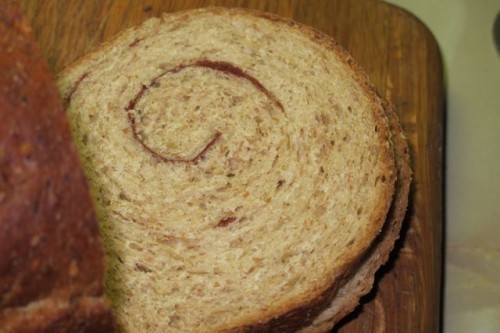
In the colder months I bake bread once a week. Since I work from home most of the time, it's pretty easy to incorporate the mixing, kneading, rising, and baking into my schedule. (The whole process takes about 3 hours.) Plus, when it's really cold I get to turn on the oven for bonus heat in the kitchen! For those of you with a 9-5:00 schedule, winter weekend mornings are a great time to let the bread dough lead the way.
Each December I bake something delicious to give to friends and family for holiday presents. Some years it's cookies (See last week's Chocolate Ginger Snap post); some years it's traditional Christmas stollen, while others I get into the whole rhythmic process of making a bunch of yeasted breads.
When this urge hits me, I turn to the recipe for "Sesame-Oat Cinnamon Swirl Bread" from Beatrice Ojakangas Great Whole Grain Breads Cookbook (p. 127). The bread itself has a fantastic texture—the oats combined with the toasted sesame seeds and wheat flour. Sprinkling the cinnamon and rolling it up adds a festive, fun touch to the process.
If that's not enough: it smells DELICIOUS as it's baking. I advise my giftees to toast slices to recreate the great smell. Instant nostalgia. Nice.
I like this cinnamon loaf compared to other recipes because it isn't sweet—and this quality only serves to highlight the excellent cinnamony nature of the bread.
Give it a try.
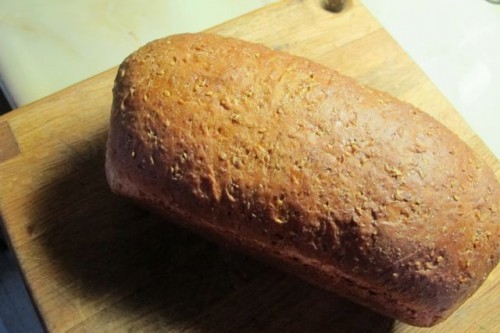
Recipe:
(I've adapted this slightly from Ojakangas' original)
1 ½ c. Boiling water
1 c. Oats (quick or old-fashioned)
½ c. Sesame seeds
¼ c. Unsalted butter, cold
1 Tbls (one package) Active dry yeast
½ c. Warm water
½ c. Brown sugar, packed
2 tsp. Sea salt
1 c. Whole wheat flour
3 c. Unbleached white flour
1 Tbls. Ground cinnamon
Combine the boiling water and the oats in a big mixing bowl. Set aside. In the meantime, toast the sesame seeds in a small frying pan, about 3-5 minutes (until the seeds begin to pop). Stir the seeds into the warm oat mixture. Add the cold butter to the mixture. It will melt and cool the mixture at the same time.
In a separate small bowl dissolve the yeast in the warm tap water. Add the brown sugar. Let stand for 5 minutes until the yeast turns frothy on top. Add the salt and the cooled oat mixture.
Add the whole wheat flour and (by hand) beat in the white flour until you have a stiff dough. (You may need to add up to an additional 1/2 c. of white flour if your dough seems wet.) Let rest for 15 minutes.
Turn the rested dough onto a lightly floured surface and knead for 10 minutes, until smooth and satiny. Kneading is fun, and it's great exercise for your forearms!
Wash your big bowl, add a drop or two of oil (I use olive oil), add dough to bowl, turn over to grease top. Cover and let rise for about an hour—until it's doubled in size.
Punch the dough down and divide in half. Roll each half out to make a rectangle (about 8×12 in.). Sprinkle each half with half of the cinnamon.
Roll up tightly. Seal the seams and ends.
Grease two loaf pans. (I use canola oil). Place the loaves into the pans. Let rise until doubled, about another hour.
Heat oven to 375. Bake until the loaves are golden and sound hollow when tapped on their bottoms. About 30-35 minutes. You don't want to under-bake these loaves or they will deflate and crinkle on top.
Remove from pans and cool on wire racks. Yum. This recipe makes two standard loaves, but it's easily doubled.
December 4, 2011
Holiday Happiness: The Chocolate Ginger Snap

For 10 years, I helped run a literary reading series here in Pittsburgh. Each month I baked something for the impromptu potluck on the side tables of the sculpture loft where the Gist Street Readings were staged. The raves for my chocolate ginger snaps never stopped, even after 10 years in the rotation.
After ending the series last December, I haven't had as many excuses to make cookies. But with the holiday season rolling around, there's the great grand practice of food gift giving to get me going.
This past weekend I made a batch of these cookies for a dinner party at my friend Christina's house. The snaps are her favorite. She made a luscious cardamom-mint ice cream to go with them.
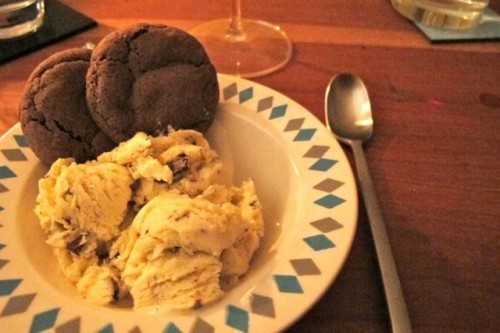
I like the process of cookie baking. The mixing of the dough. The parsing out of little cookie balls on the sheets. The setting of the timer. The waiting. The trading of a baked tray of cookies for an unbaked tray. The levering off of the cookies onto the cooling racks. Repeat. The stacking of the cooled cookies into tins. The giving. The eating.
Not too snappy, not too chewy, these cookies are a great go-to present for neighbors, co-workers, friends, family. In an airtight container they keep for as long as you can keep from devouring them.
Recipe:
Chocolate Ginger Snaps
[Adapted from Mollie Katzen's recipe in Still Life with Menu, p. 206.]
½ c. Unsalted butter, room temperature
½ c. Soy margarine, room temperature
2 squares (2 ounces) unsweetened chocolate, melted [I've also used bittersweet and semi-sweet chocolate to great success.]
1 ½ c. Granulated sugar
¾ c. Brown sugar, packed
¼ c. plus 2 Tbls. Molasses
2 Large eggs
2 tsp. Vanilla
4 c. Unbleached white flour
1 ½ tsp. Baking soda
1 Tbls Fresh ginger, minced
2 tsp Ground ginger
1 Tbls. Crystallized ginger, minced
½ tsp. Sea salt
Preheat oven to 350. Cover cookie sheets with parchment paper.
In a large mixing bowl cream butter and margarine on high speed. Drizzle in melted chocolate and beat well. This mixture should be fluffy. Scrape down the sides of the mixing bowl at intervals. Add sugars, molasses, and eggs. Beat several more minutes, still thinking: fluffy. Stir in vanilla.
In a separate bowl combine flour, soda, gingers, and salt. Ease this into the mixer (now on low speed). Combine just enough so that the dough is incorporated into the wet mix. I finish mixing by hand. Do not over mix! The finished dough should feel silky.
Dig out heaped teaspoonfuls of dough, form into round balls with your (floured, if necessary) hands. Place the dough balls in staggered lines on the parchmented cookie sheets. Bake on the middle rack of your oven for 10 minutes. The tops will begin to crack and the bottoms will just begin to brown.
Remove to cooling rack. Repeat. Eat warm, if you're lucky.
This recipe makes approximately 4 dozen small cookies. (It can easily be cut in half for a less festive amount.)
November 26, 2011
$35: A Week of Healthy Eating
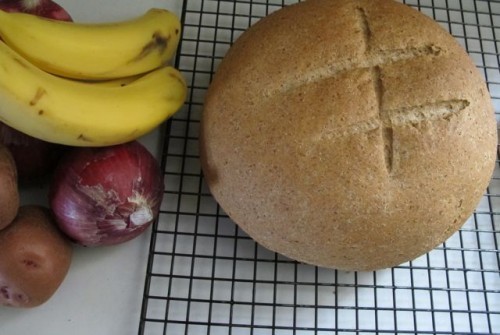
$35: one week of healthy food. I thought, surely a person could try this experiment while eating healthy, local, and organic. No processed foods, no problem.
Sure, I thought again—just a bit doubtful. I like a challenge.
Cory Van Horn (at Culinary Cory) and Hal B. Klein (at This Man's Kitchen), two fellow food bloggers, joined in. After a flurry of email exchanges about ground rules, we decided to have as few ground rules as possible. $35. No processed foods. Garden produce was cool. Bartering, cool.
The idea of bartering led to a discussion about the importance of community and friendship in food circles. It's much easier to eat cheaply if you're joining together with others.
We also talked about cooking skills—how knowing how to cook, how to garden and prepare food efficiently is one key to avoiding processed foods. We talked about time versus money. How, for me, having a non-traditional work schedule lends itself to, say, baking bread on a Monday morning.
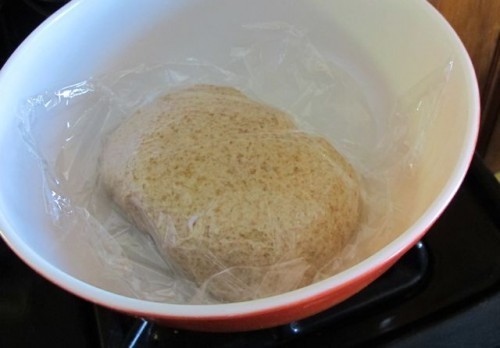
The week itself surprised me. I planned ahead; tried to be organized with my purchases. I intended to make as much as possible from scratch since that's my nature anyway. It was clear the first thing to go was booze. No booze. I couldn't give up coffee, so it became (and remained) my highest single line item. A half pound of beans: $4.50 for the week. Second highest line item? A big tub of organic low-fat yogurt. $3.99.
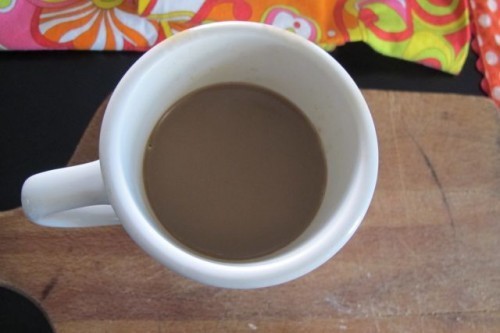
I wanted to work the bulk bins—in both the Penn Mac Italian store in Pittsburgh's Strip District and at my local East End Coop. This, I reasoned, was the best way to be exacting in my measurements. So instead of buying a whole bag of rye flour, I could buy 2 cups worth for my bread.
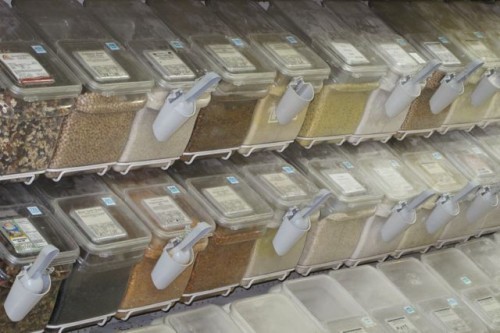
The second most surprising realization was how little cheese I could purchase. I wanted a good Parmesan—a 1/4lb of cheese later, I had my limit. Yikes. I also purchased 1/4 lb of some inexpensive (but locally made) marbled Jack-Colby at the coop.
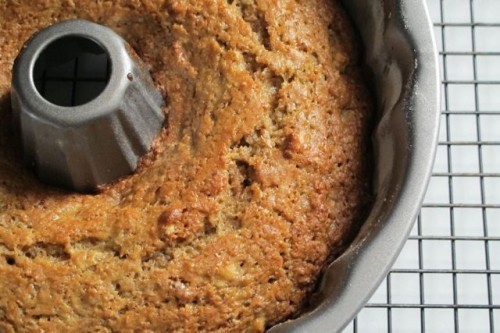
I felt the fun trickling out of my week. No booze, tiny cheese. That's when the lemon banana cake recipe floated into my list. I had budgeted for 3 bananas (which I planned to cut in half) to top my morning granola, but I decided instead of diligently rationing them out over the course of a week, I'd blow them all at once in the cake. I also decided to fancify the cake by baking it in a bundt pan. The cake was a big success and came in handy for both breakfast and afternoon snacks.
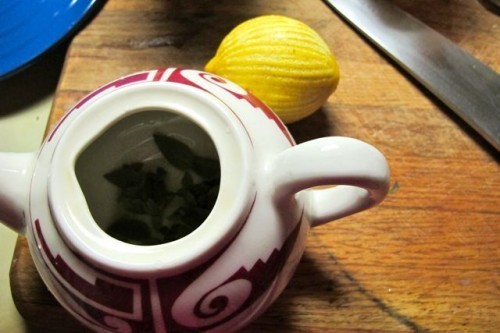
Speaking of snacks, this is where it got heady for me. I'm not a huge snacker. I like to eat something in the late afternoon because I tend to eat dinner pretty late into the evening. Because I tend to eat dinner late, I'm not really an evening snacker. With this new diet, I found no room for cheese and crackers, no room for popcorn. Because each of my meals was sparse and exacting, I had this gnawing urge to SNACK. I wanted something salty and crispy and I just couldn't have it. What I found, instead, was that I started to eat dinner a little earlier each day.
In retrospect, my feeling of hunger around snack time was a false hunger—something I'd been trained to want, but that I didn't really need. Snacking spoke up as the luxury it is. Instead, I drank more water and made tea with herbs from the garden: peppermint, lemon balm.
Here's a rundown of my weekly menu.
Breakfast:
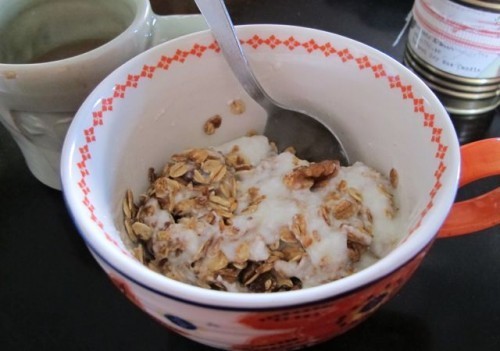
My morning food alternated between granola with yogurt, banana cake, or toast. (I make granola from scratch each week in my normal routine but costed out the ingredients for this week's servings.) I traded two pieces of banana cake for a smoothie made by my lovely friend Christina Worsing.
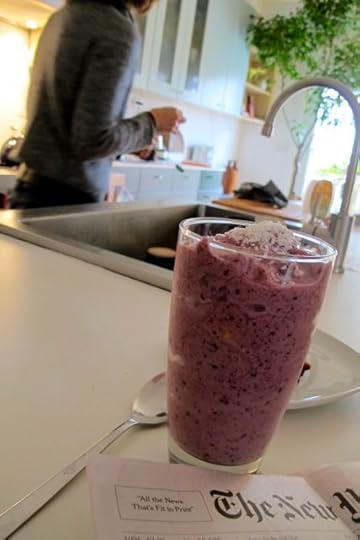
Lunch:
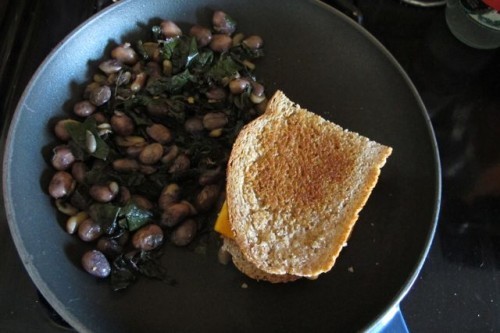
I made grilled cheese (just once!), granola with yogurt, leftovers from dinner. I traded copy editing advice for a lovely lunch made by the fantastic Leslie Fleischer.
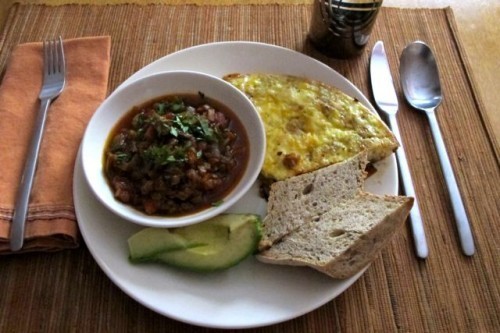
Dinner:
I made dinner for two each night. It began with pasta, tomato sauce (homemade from frozen garden tomatoes), and kalamata olives—plus sautéed greens and beans.
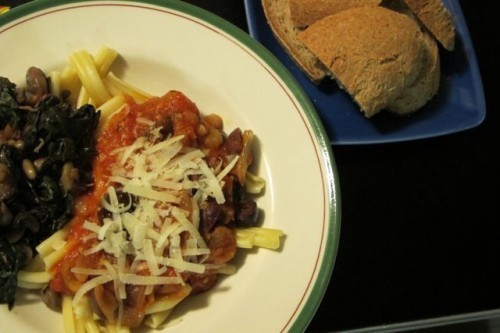
Next, I put together a Squash/Kale/Cannellini Bean stew. I traded two servings of the stew, its recipe, and one jar of my apple-pear chutney for dinner at a local restaurant Legume, paid for by the wonderful Jesse Eusades and Liza Hall. (My dinner alone that night cost $38, btw. It was delicious.)
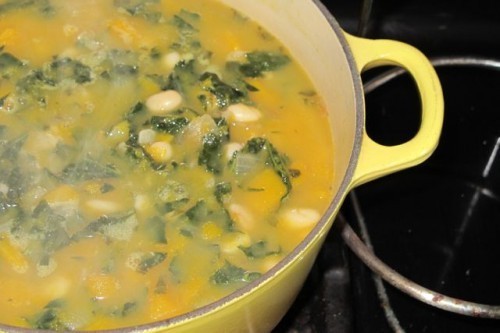
I made pizza with marinara sauce and loads of caramelized red onion with salad.
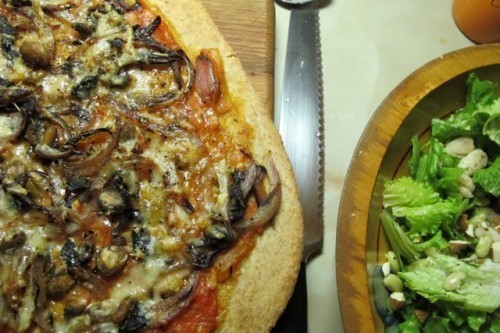
And then finally, turnovers with sautéed greens and garlic and a steamy potato gratin.
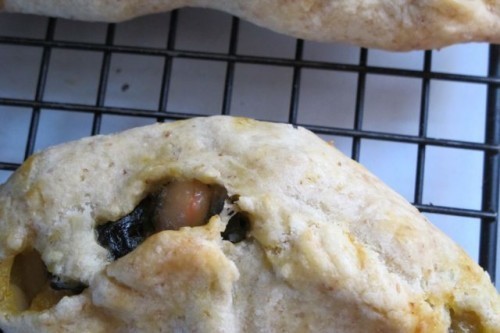
How it came together:
Sunday:
Shopping day.
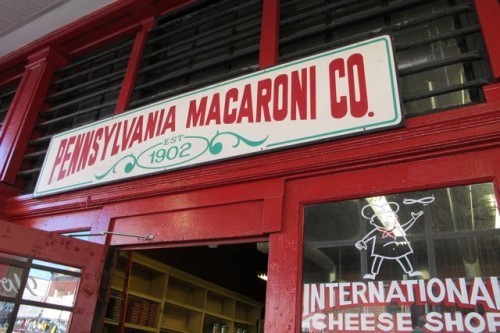
Monday:
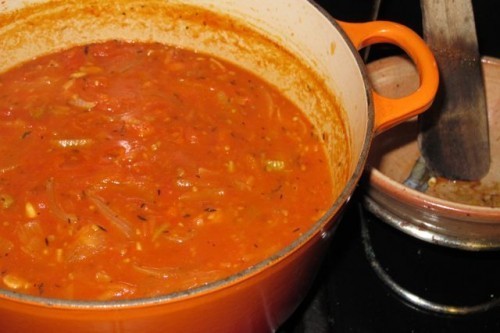
Major cooking/baking day: homemade whole grain bread, pie crust, pizza dough, granola, and homemade tomato sauce with garden tomatoes frozen from summer (with fennel and carrots and garlic from the garden). I ended up with 6 cups of sauce. I also soaked the beans Monday night for Tuesday's stew.
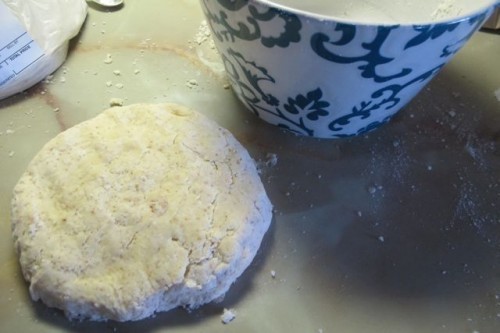
Tuesday:
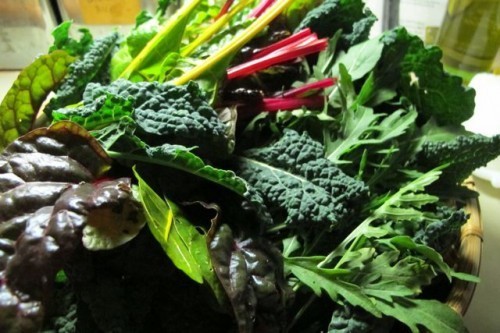
I made the Cannellini beans in the pressure cooker (saving the bean water for stock) and then put together the Bean/Squash/Kale stew, with kale and squash from the garden.
Wednesday:
I thawed the dough I'd made on Monday and put together a pizza with the homemade sauce. I added leftover greens and a big mess of caramelized red onion and some (of my precious) grated Parmesan cheese.
Thursday:
Rerun of pasta with tomato sauce but this time I added leftover Cannellini beans to the sauce to shake things up a little bit.
Friday:
I pinched together turnovers made with the pie crust I'd made on Monday and refrigerated; I strained the rest of the stew for the filling.
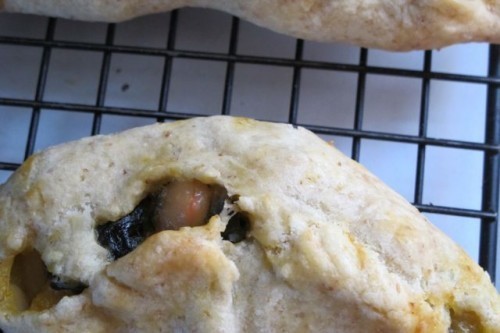
Saturday:
I put the local potatoes I'd purchased at the coop to use in a steamy gratin.
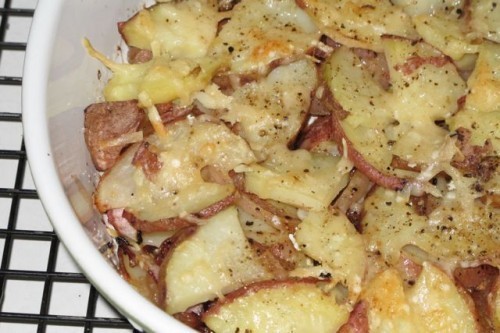
Sunday:
Leftovers.
Total spent: $38.51
Total time cooking/baking: 13 hours
What I bought in bulk: kalamata olives, walnuts, almonds, oats, honey, unbleached white flour, cardamom, thyme, cayenne, cumin, demerara sugar, Cannellini beans, whole wheat flour, rye flour, shredded coconut, imported Parmesan cheese.
What I bought, not bulk: 1 bag of fancy pasta, milk, colby-jack cheese, soy margarine, organic potatoes, local onions, organic leaf lettuce, organic bananas, tub of yogurt, lemon.
What I used from the garden: kale, garlic, fennel, carrot, butternut squash, tomatoes (frozen), a variety of herbs.
What I used from my kitchen: olive oil, butter, eggs, coffee beans, yeast, salt, pepper. (I costed out the eggs and coffee beans.)
Please visit Cory and Hal's blogs to read their insightful posts on this project:
November 3, 2011
A Pressing Matter: Hard Cider
Today's guest blog is brought to you by writer and editor Bob Hoover
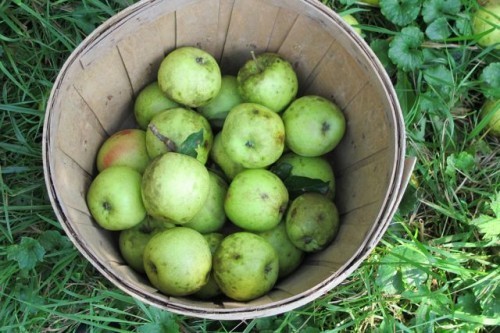
I've been making my own cider on and off for 30 years as a productive way to use my extra "capacity" from a formerly busy home brewing operation; that is, the leftover bottles and empty fermenting vessels.
The sweet or unfermented cider came from local apples pressed into juice and sold at farmer's markets. That's where I first met Don Kretchmer, then a lone voice of organic farming who brought his beets, greens and cider to the city's first farm market on the North Side of Pittsburgh in the early 1980s.
There was only one in those days, Fridays in a parking lot across the street from West Park. I would get five gallons from Kretchmer and turn it into hard cider in my fermenting "cellars," the chilly basement of my Mexican War Streets home.
[image error]
Over the intervening years, I've tried other sources of cider, probably the best a serious orchard in Washington County which provides the juice to several state wineries, but I had always wanted to get the stuff the way the French apparently do from ugly misshapen, rough apples that were rejected for eating and left to rot on the ground.
These apples were shriveled from drying, meaning the sugar in them was concentrated, turning the cider made from them into a perfect medium for the "Pasteur" commercial champagne yeast to convert it into a pure, maybe even organic hard cider.
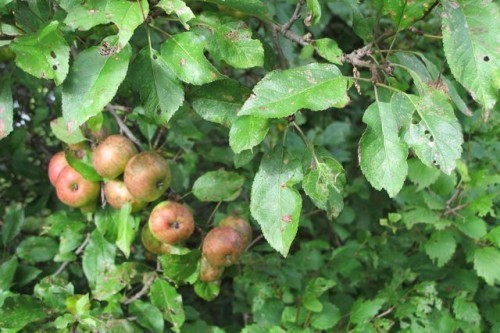
Sherrie Flick to the rescue. Untended apple trees sprinkle her family farm in faraway (well, two hours) Forest County, Pennsylvania. There I could pick all the apples I wanted and store them in the farm's spring house to let them concentrate that sugar.
So, one beautiful September day, my wife Kathleen and I joined Sherrie and spouse Rick Schweikert at the farm to collect the fruit. Using paper yard bags, we scooped small, mostly green apples from the ground and yanked bunches more from the trees – about eight bushels as it turned out.
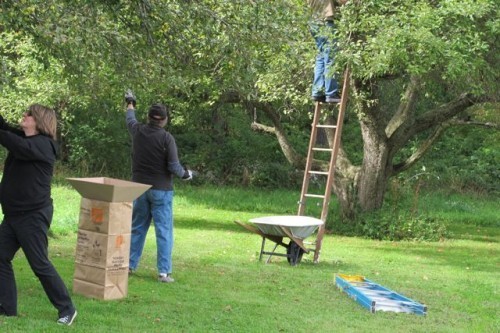
We spread them on tarps inside the spring house and vowed to return in a few weeks. The plan was to cart them to Sally's Cider Press on Route 19 north of Zelienople and turn our windfall into our own vintage of cider.
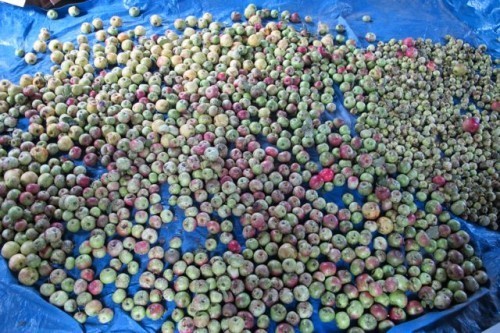
The plan worked to perfection, amazingly. When Kathleen, a house guest Susan Poats who lives in Ecuador, and I returned to the farm early one Saturday, Rick met us with bags of apples he had filled on his own, sparing us the labor. We added dozens more to the collection and set off for Sally's, arriving around 11:30 a.m.

Others with the same idea were filling the plastic gallon bottles with foaming brown cider when we showed up. Immediately, Sally's crew turned to our crop and began feeding the apples to a conveyor that sent them upstairs to be crushed.
That's the first step. The chopped apples were then dropped into a wide wooden frame filter, covered with a porous cloth, and crushed by a mechanical press.
[image error]
We grabbed paper cups to taste the first pressing, a rare sensory experience of sweet, fresh juice right from the apples.
Then the juice flowed to a basement tank where it passed through an ultraviolet treatment to kill those intestinal-racking bacteria. Sally's provides metal tables, filler hoses and jugs for the newly minted cider makers to capture their product.
We produced 19 gallons of cider, dirt cheap for $38 and the price includes the jugs.
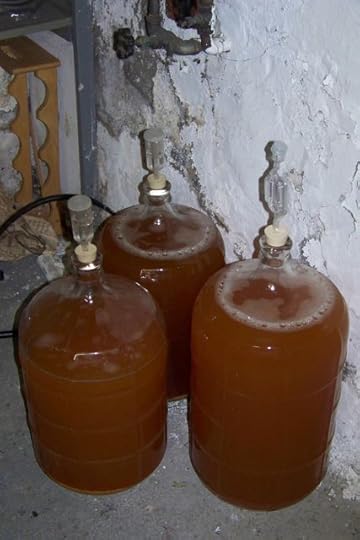
I now have about 15 gallons happily fermenting their way into dry, crisp hard cider ready to drink in six months. Late in December, I will bottle the alcoholic cider (should be about six percent booze) into 22-ounce bottles and cap. The cider has been primed with a small amount of sugar that will wake up the dormant yeast just enough to restart fermentation and create carbonation in the bottle. Then, sometime around a blisteringly hot July, I'll chill a bottle and enjoy my own cider made from Flick Farm apples.
A little history of hard cider
There's plenty of evidence to show that our American ancestors lived in a state of moderate inebriation, high mainly on fermented apple juice or hard cider.
An observer writing about colonial Massachusetts estimated that cider drinking was so pervasive that annual consumption per capita was 35 gallons. That state's favorite son, John Adams, started every day on his farm with a flagon of cider before turning to his chores and working on early drafts of the Declaration of Independence. He died at 91.
Hard cider has been an every day drink in Western culture since the Roman Empire and it continues to flourish today in Great Britain, France and Spain. Normandy and Breton ciders are as prized as good wine and produced with equal care while the British and Spanish maintain large orchards of ancient varieties of apples cultivated for cider alone.
By the early 20th century, cider fell out of favor in the States, squashed by cold winters and the Christian Temperance movement, which inspired many a farmer to chop down his apple trees before Carrie Nation took her tiny ax to them.
Now, the drink is returning to America. Producers from microbreweries to local artisans are churning out decent cider again. The other day, I found Philadelphia Brewing's cider on tap at D's in Regent Square. Occasionally, the products of the tiny Arsenal Cider Works are served at Fat Head's on the South Side.
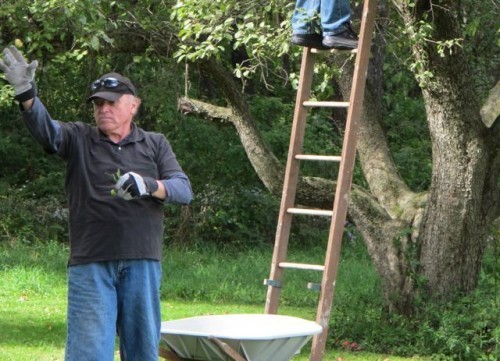
The book editor of the Pittsburgh Post-Gazette, Bob Hoover has been reporting and commenting on both the creative and commercial side of writing and publishing for more than 25 years. He edits the newspaper's Sunday book section, contributing both reviews and a column as well as overseeing the section's mix of criticism and news. Nationally, he has regularly covered the leading publishing trade show, BookExpo America, the National Book Awards, the National Book Critics Circle Awards, and the National Book Festival in Washington, D.C. He's a member of the National Book Critics Circle. In March 2007, he traveled to Cuba where he followed the literary trail of Ernest Hemingway, writing about and photographing the writer's haunts there. Hoover also has interviewed many of the nation's major writers, poets, and historians and written profiles of such writers as David McCullough, August Wilson, John Edgar Wideman, and John Updike.
October 26, 2011
Grilled Cheese Improvisation: Delicious Pear Slices
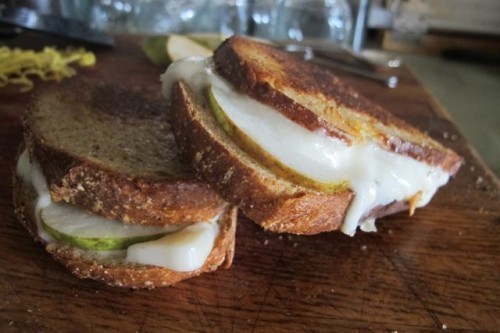
It has been an apple and pear obsessed fall. Apple pie, pear cake, applesauce and jelly. It goes on and on. So many apples and pears to pick, and then so many recipes to use them in.
My Aunt Laura and Uncle Bill have a beautiful pear tree on their property, and with a bumper crop this year, they put a call out for anyone who could help diminish their bounty of Starking Delicious pears.
Mid-sized with excellent taste and a smooth greenish speckled skin, these pears are perfect for chutneys and cakes, and I've discovered—excellent sliced onto a grilled cheese sandwich. The gooey-warm cheddar cheese contrasted nicely with the crunch of the pear and the crusty buttery excellence of a good 7-grain bread: Delicious. It's true.
October 19, 2011
Pear Yogurt Muffins: Think Fall
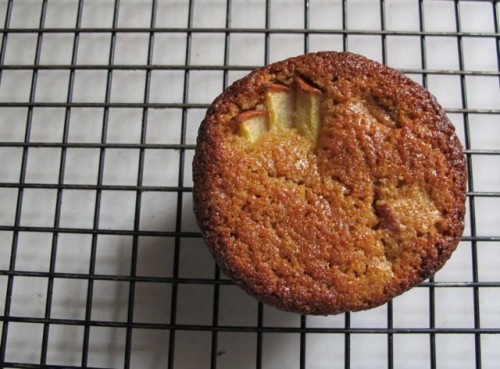
I can't remember a Fall when I cooked and baked more pears and apples. Chutneys, pies, cakes, and jellies have lined the cooling racks and pantry shelves through September and October giving my kitchen a sweet nostalgic smell.
I thought I'd gotten it all out of my system after we pressed 20 gallons of cider from my parents' farm apples, but then I stumbled upon some lovely red pears at the market and this Pear Yogurt Muffin recipe was born. Moist and crisp, these little guys embody a fall morning.
Recipe
1 ½ c. whole wheat pastry flour
1 ½ tsp baking powder
¼ tsp nutmeg
1/8 tsp salt
2 large eggs
1 ½ Tbls vanilla
1 Tbls lemon zest
1 c. packed brown sugar
4 Tbls melted butter
Scant ¼ c. canola oil
¾ c. plain yogurt
¼ c. apple cider or apple juice
2 large pears, cored and thinly sliced
Preheat oven to 400
Mix together flour, baking powder, nutmeg, and salt. In a separate bowl whisk eggs, vanilla, zest, sugar, butter, oil, yogurt, and cider. Set aside enough trios of pear slices to adorn 6 muffins (18 slices!), and then cut the slices in half so you have enough for 12 (36 halves!). Chop the rest of the pear and add to the egg mixture. Combine wet and dry ingredients. Do not over mix!
Pour batter into prepared muffin pan (either filled with muffin papers or oiled or buttered) and then top each cup with 3 halved pear slices, sticking them in so they stand up like a sail or a shark fin, depending on your mood. Bake for 20-25 minutes or until a knife inserted into a muffin comes out clean. (I recommend letting them bake long enough to crisp a little at the edges, like in the photo.)
Cool to room temperature, if you can wait that long (I couldn't). Eat up.
Contrary to baking rule of thumb, these muffins are even tastier the second day.
Enjoy.
October 12, 2011
Sherrie Cooks (at Chuck Kinder's House): Slaughtering the Squash
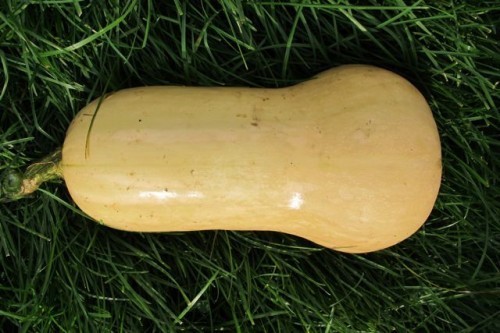
I'd been stalking the squash for weeks. Sure, vegetables move slow, but you never know when they're going to deceive you out there, looking innocent in the garden.
Clips in hand, I went at it speedy-like in the early dawn with dew on the grass and the birds singing, squirrels scampering, and the pack of urban deer out on the neighbor's lawn, looking like they're on a smoke break before decimating the raspberries.
I don't have ethical convictions one way or another about slaughtering butternuts. It had to be done. I had dinner to make. Greens to sauté. Clip. Clip. And it was over. Painless. I cradled the five-pounder in my arms, walked back inside, my little dog nipping at my heels.

This is how I came to make dinner for writer Chuck Kinder. I approached the idea of butternut stew, an estranged vegan third cousin to the road-kill stew Chuck has concocted for his students, friends, and enemies for years, because I wanted something orange and thick bubbling in the bowls on the table. A mix of Cannelini beans, kale, and butternut was just the thing. It glop-glopped on the back burner all afternoon.
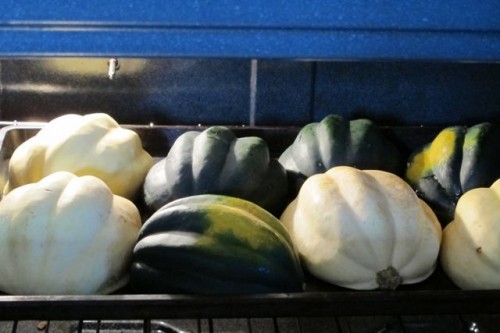
I also looked into purchasing some pre-slaughtered acorn squash, white and green, at the local coop. They were good roasters and had led a happy, local life, I was told.
Thematically, I wanted my Kinder dinner holding itself together. Kinder understands, afterall, detail, plot, character, syntax. I wanted to tell a story with my food. The story was this: it is early fall, and we are happy.
Kale. Pear. Squash: my characters. Garlic, onion, cumin: the details.
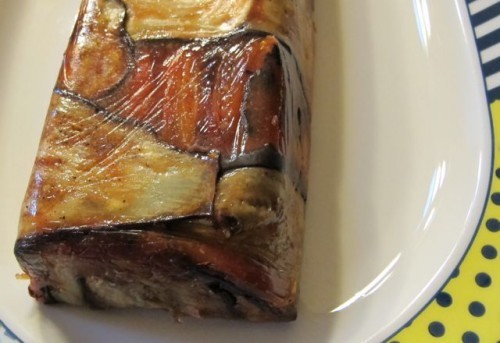
The Menu:
Vegetable Terrine (by Diane Cecily from a crazy-hard Martha Stewart recipe); Cheese Tray (by Diane Cecily with a gorgeous hunk of aged Pecorino brought by Hilary Masters); Roasted Pear-Bleu Cheese-Pecan Salad with Cranberry Vinaigrette; Slaughtered Nut Stew; Stuffed Acorn Squash; Cornbread; Roasted Pear Chutney; Pear Cake; Bittersweet Chocolate Tart with a Brown Sugar Crust; Bourbon Brambles (Shaken by Rick Schweikert); Wine; Beer; Vodka; Champagne.
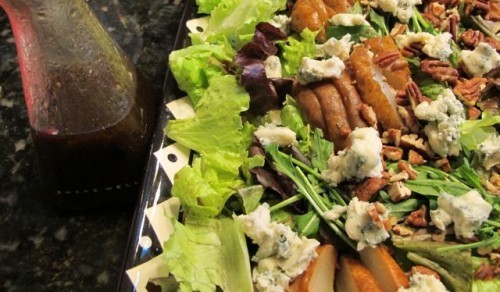
In Attendance:
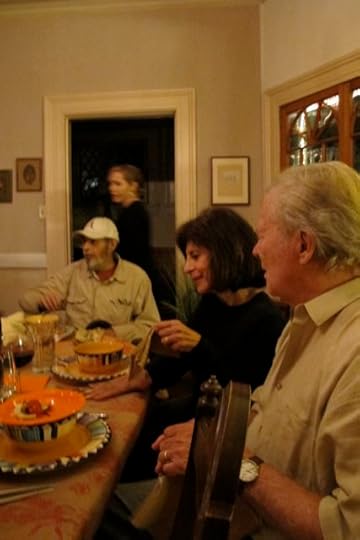
Chuck Kinder, Diane Cecily, Rick Schweikert, Sherrie Flick, Hilary Masters, Kathleen George, Marc Nieson, Josh Barkan, Roger and Jeanne LePage.
[image error]
Several people took on writing assignments beforehand. Rick tackled "Grace."
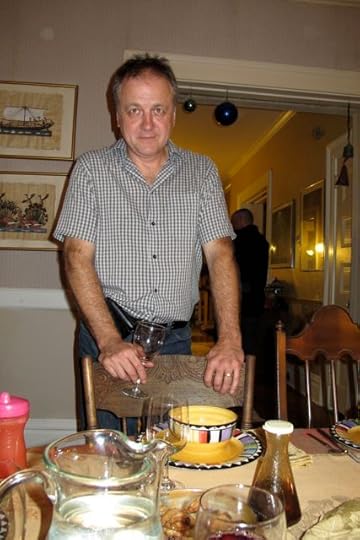
Grace
By Rick Schweikert
To the simple fact of an empty bottle of beer,
To the complexity of stars,
To the solemnity of an unexpected pause,
(long pause)
We pray.
To the gravity of irony,
To the lowly worm,
To the tyranny of moderation,
To unfathomable birth,
And to the food that strengthens our bodies to the service of all that is good,
We pray.
Amen.
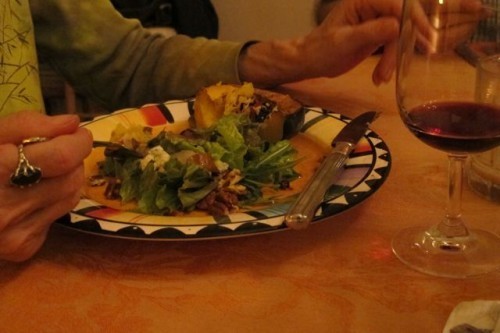
Kathy toasted with these lines from Taming of the Shrew:
And frame your mind to mirth and merriment,
Which bars a thousand harms and lengthens life.
[image error]
Josh contributed a limerick—the first he's ever written—that included possum, cornbread, and roadkill…There were two versions…
Limerick
by Josh Barkan
(Clean Version)
There once was a possum that was ugly,
a roadkill hit by my friend Dudley,
we stirred it with spices
picking off the lices
now with cornbread the possum is snuggly

Diane contributed an amazing anecdote…a childhood memory unearthed while renovating her study.
The Necklace
By Diane Cecily
If I were to describe my retirement years, I would say they are project driven. The kitchen, the third floor, the second floor bathroom, the red room, the blue room, and most recently my study. By far the most interesting on a personal level has been redoing my study. Not just the wall repair and paint jobs, but the heave hoe job as well. Over the years my study has become the place to store things that have no logical reason for hanging around other than that I just can't bring myself to toss them out. Not just yet. And so the recent project has become a journey of sorts, sifting through old boxes of family albums, pictures, mysterious containers. In the course of this cleansing, as it were, I came across a small well-corn leather bound jewelry box. At the bottom was a small half-round clear plastic container. Inside I found a gift that had been given to me in the 6th grade, one I had forgotten about over the years, though it continued to travel with me from one life to the next.
As I looked at it, I thought about the recent news coverage of a young boy who had killed himself, the victim of bullying. But let me go back to that time in grade school. I lived in Helena, the capitol of Montana, and that gold-rush town was enjoying a population boom. In fact, just that year the school board in emergency session had agreed to open four classrooms in the condemned old school house that sat on a hill behind the shiny new school just to accommodate the influx of fifth and sixth graders.
There was a new girl in our class that year. Her Name was Norma Jean. She was a tiny, pinch-faced girl with over-permed red hair and a blotchy complexion. She pretty much kept to herself, head down, never volunteering in class. We all gave her covert looks, but kept our distance. Then Jeff, a smart-ass whose father owned the downtown shoe store discovered she had a peculiar doll in her desk. He waited in the hallway until she left the room for recess, then motioned for us "in the know" to follow him back into the room where he lifted up the desktop. Sure enough. Right inside was a miniature Va-Va-Voom with a short tight skirt, fishnet stockings and a tight strapless top. Best of all, as Jeff quickly demonstrated, one only need squeeze this rubber blonde bombshell in the middle and her top fell down revealing boobies I would have killed for. Well that was it for Norma Jean's anonymity. She was called the Booby Girl, and boys asked if they could squeeze her middle. She left school in tears that day. Next day she didn't show. And the day after that. Then on the third day the school got a call that she was sick. The teacher asked who would volunteer to bring her homework to her house. No hands. By this time I was feeling a bit crummy about what had happened and I reluctantly raised my hand.
After school, armed with her address, I walked the few blocks to her home. It turned out to be an apartment up a narrow flight of steep stairs. I knocked and she let me in to a shabby little room with dirty brown carpeting and torn lace curtains in the two windows. Off to one corner was a small stroller with a baby inside. I looked closer. The baby was real. It stared back at me with wide brown eyes. "My sister's," she explained. I didn't intend to stay long. Just talk about her assignments. But she seemed genuinely glad to have a visitor and fixed me a glass of water as she explained how she was babysitting while her sister worked. My birthday was coming up, and before I knew it, I was asking her to join us this Friday – it would be all the girls in our class, no boys. She said she would see.
To make a long story short, she did come, and she brought me a present. It was what I found all these years later in that worn jewelry box — a rhinestone necklace with a broken clasp. She had tied two black velvet cords to each end so I could tie it around my neck. I was profoundly touched.
She never came back to school. Many times I thought about stopping by her apartment to visit her again, but I never did. And while I never wore the necklace, I kept it as a reminder of who we were and who we might have been.
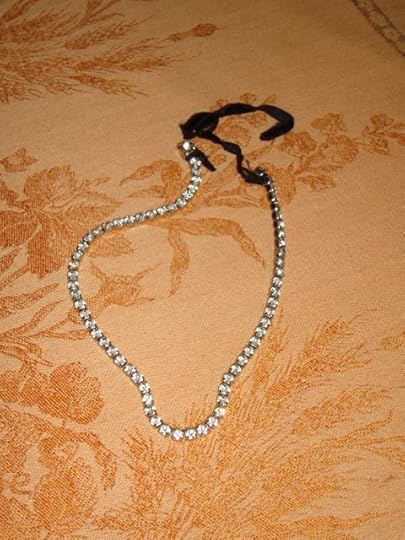
Mr. Chuck himself wrote his story of the Roadkill Stew's origins. He feared getting too sentimental and so Diane donned his cap and read it aloud to us.
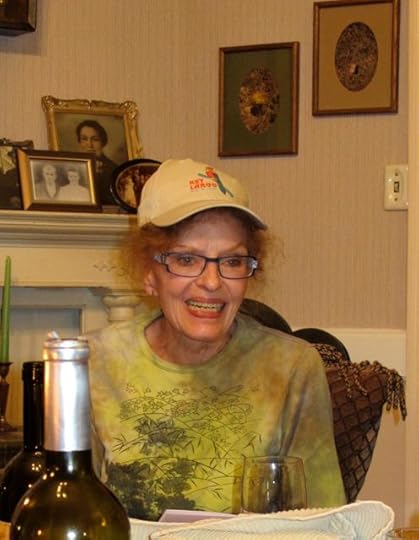
THE KINDER ROAD KILL CAFÉ
By Chuck Kinder
My paternal grandmother had been the matriarch of our family. Daisy Dangerfield was her maiden name, but everybody simply called her Mimee, and Mimee pretty much ruled our extended family with a will of iron, a wicked humor, and a soft heart, which was essentially the way she also cooked, meaning that wherever it was Sunday Supper stew or meatloaf, or moonshine, Mimee would stir relentlessly while cackling at her own jokes or sometimes weeping whenever she made her sentimental soup. I returned to the Mayo Clinic for the third time in my life (out of four visits), when I was twelve and in the seventh grade. There was to be no surgery on that particular trip, only a general checkup of my condition. Since my old man had been in the midst of another of his many business break-downs at the time, and my mother was being forced to work midnight shifts again as an emergency room nurse during the course of that particular family downfall, which was not as bad as it could have been, meaning this time there would be no sheriff banging on the door at dawn waving bad checks like little arrest me flags in the air nor any escapes from town under the cover of darkness. None-the-less, Mimee announced that she would drive me herself across that seemingly endless Midwestern vastness from West Virginia to Rochester, Minnesota, in order that her beloved, if somewhat gimped grandson could be made as good as gold with the help of modern medical science. I was the oldest grandchild and the proverbial apple of Mimee's eye, but we really bonded for the first time as potentially adult friends on that flat boring three-day trip west (and then our return east), when we had discovered with an intensity of understanding and a new immediacy of sympathy that one of our mutual fascinations and sort of hobby was road-kills.
Mimee was an expert when it came to road-kills, and she had seen them all, including a black bear hit by a coal truck, and a Southern Baptist preacher run over by his long-suffering wife. And then there was Aunt Shorty, who had been backed over in her own driveway by Mimee herself as they were heading for church. One Sunday morning, on account of the fact that Aunt Shorty was the family's only midget, and Mimee simply had not seen Aunt Shorty in the rearview mirror when Mimee was backing her car up. Well, Mimee was real sorry she had run Aunt Shorty over but anybody that short should have had the good sense not to walk behind a moving vehicle was Mimee's basic attitude, and Mimee had honked the horn afterall, and they had given Aunt Shorty a real nice funeral and proper burying, but it was still a real pity that Aunt Shorty's life had been cut so short, so to speak, was Mimee's basic attitude. Mimee was nearly psychic in the department of predicting the number of dead dogs we would pass per mile, depending upon the condition of the road, speed-limit, traffic, and weather. And Mimee knew enough road-kill recipes to fill a cookbook with old canine cuisine family favorites such as Slab of Lab, Round of Hound, German Shepherd Pie, Pit Bull Pot Pie, Cocker Cutlets, Poodles 'n Noodles. ("You'll eat like a hog," Mimee would cackle, "when you taste my dog.") And then there was that old favorite pancake substitute, Flat Cat (served as a single, or in a stack), and Chunk of Skunk, Smidgen of Pigeon, Swirl of Squirrel, Snake Shake 'n Bake, Smear of Deer, and what she claimed had once been her real Sunday supper speciality, Center-line Bovine, with all the trimmings, such as Critter Fritters, and Road Toad A La Mode.
As we rolled endlessly across that great doze called Ohio, that wonderfully nutty old woman and I decided that someday, her road-kill casseroles would make us rich. Someday, we decided, as we laughed and hooted around, and did not think of doctors and hospitals and nasty nurses with needles the approximate size of harpoons, we would open The Home-Cooking Road-Kill Café and make us a mint with gourmet hits like our daily takeout lunch sandwich special: Bag 'n Gag, meaning anything around handy dead between bread.
Old-timers down in the hills of West Virginia will tell you that often critters once thought extinct sometimes wander out of the mountains at night, critters that look like they are half-this and half-that and they attempt to drink at the pavement of roads as though it is the fresh water of a mountain creek that moves so slowly you can hardly see it passing, and being creatures from a forgotten time and place and sacrificial in their innocence, they look up unafraid and hopeful into headlights hurtling toward them out of the dark, and the next thing they knew they were in somebody's soup.
Guess That Mess, would have been another of the daily specials at the Kinder Road-Kill Café, meaning if the customer could guess the nature of that menu-item critter so ancient and rare that it was almost imaginary, that customer ate for free.
Mimee and I were not ten miles from home after our return trip from the Mayo Clinic when we came upon a road-kill critter beside the road that once could have been a huge cat with the face of a bat. Mimee pulled the car over as was her wont. And we got a road-kill critter coffin out of the trunk, which was simply one of the cardboard boxes Mimee always carried just in case. While I stumbled around beside the road trying not to barf, Mimee scraped up the critter's dripping remains and gently deposited them in the box. Now one of two things would happen. If the road-kill critter looked as though it might have been somebody's pet, say with tags around its neck, or if it was a critter so bizarre in appearance that Mimee had no idea what the nearly extinct thing might have been, well, that critter was named and taken to the family cemetery to be buried with some ceremony in order to become Aunt Shorty's personal pet in the next world. Otherwise the critter was carried home to become the family's supper. I could never predict which way Mimee would decide. If it was a supper decision, Mimee would personally skin and prepare the critter for the pot. Mimee would begin by marinating the critter in moonshine for at least an hour, whereupon she would sprinkle the prepared critter with paprika, salt, and pepper. Then melt ¼ cup of butter in an iron skillet and brown the critter quickly over high heat. Then remove the critter and set aside in a warm place. Melt another ¼ cup butter in the skillet and add a mess of ramps in season and cook until brown. Add Blair mountaintop mushrooms and saute until all liquid has evaporated. Add two tablespoons of flour and mix well. Gradually add cup of moonshine and ½ cup beef stock. Bring mixture to a boil, stirring relentlessly. Then simmer for 30 minutes. Remove sauce from heat and fold in ½ cup sour cream. Add critter to the sauce. Heat to just below boiling and serve the Critter Stroganoff pronto. While she was cooking her critters up, Mimee would mumble words of reverence and respect "for things about to disappear" and often she would weep for critters so ancient and lonely as to be almost imaginary in nature, not totally unlike her own poor old lonely and road-kilt Aunt Shorty. Mimee's tears added an extra taste of salt and moonshine to her dishes I learned to relish.
Mimee had gone quickly downhill ever since some teenage oaf not watching where he was going had bumped into her at the cashier's counter of a Long John Silvers, where my old man had taken her for her eighty-fifth birthday dinner, so she wouldn't have to cook as usual, and she had tumbled, broken her hip, and then gone into heart failure. Mimee had lingered long enough for us to talk on the phone when I called her from San Francisco, when she told me that while she was not exactly road-kill, She was aisle-kill, and not unlike Aunt Shorty, who had been too short for her own good and in the way, Mimee said that she had been too old and slow and in the way, which was why that idiot teenage oaf had bowled her over.
My wife, Diane, and I flew in for Mimee's funeral and burying. Diane had first met Mimee the first morning we had arrived in West Virginia as a dubious couple back in 1972. I had not yet quite divorced my first wife, and Diane, who was traveling across country to fetch me for that foolish reason called true love was clearly a fallen woman-type. Diane was scared to death to meet Mimee in the first place. I will withhold a story here, but suffice it to say that we arrived at Mimee's door that morning under a cloud. Both of my eyes were black, and my knuckles bloody and raw from a silly fracas I had foolishly been drawn into in Bloomington, Indiana, due to comments from a big jock thug I considered disrespectful to my future bride, in a tavern where we had stopped for a beer and bite This made Mimee mad as a sore-tail cat, and she declared she intended to whup me with a belt like she used to do for fighting again. But Mimee just herded Diane and I back to the kitchen hugging our arms, and she forced us to sit down for some breakfast. At one point, while Mimee was scrambling a mess of eggs and squirrel brains relentlessly with one spoon and stirring a pot of possum gravy with the other, she gazed over at Diane with unbridled, intuitive affection, and announced to Diane that where the family had gone wrong with me from the day I was born was when they had made the big mistake of throwing away the baby and raising the afterbirth. At one point Mimee had simply hugged Diane and said: "Well, honey, I figure though that if he lives that long, Chuckie will make for a pretty good old man to sink into your dotage with. He'll make you laugh anyhow." "Well," said Diane. "Then there's that to look forward to."
As Diane and I were driving out to the old family cemetery for Mimee's burying, we passed a single remaining wing of enormous golden feathers plastered to the pavement, whose tips looked like tiny closed fists that fluttered gently up out of bloody pulp in the soft wind of our passing like a vague wave of hello and adios.
Throngs of folks were at the graveside services, and family members and friends and complete strangers to me were falling apart on account of the death of that old woman, whom folks always declared I was a male dead-ringer for. I loved that old woman, but you didn't catch me wailing and crying around like all those country cousins. I was busy making mental notes on all the bizarre amusing things about the proceedings that would have cracked Mimee up if she hadn't been the guest of honor, or maybe not, besides Diane was doing enough blubbering for the both of us. When they started lowering that old woman's coffin into the ground, folk tossed a ton of flowers onto it, and I tossed in my own fistful of golden feathers, and said my own goodbyes. "What are you mumbling about over there? Are your dentures loose or something?" Diane asked. "For things about to disappear," I said more clearly.
I knew that folks would be swarming by the house after the services, and although the tables were already groaning back in the dining room with church-lady casseroles and cakes and pies and platters of fried chicken, I knew what my own contribution to the funeral feast was going to be. And I knew the recipe, like I knew all the other recipes purely by heart that Diane and I would be using to put Long John Silvers out of business.
"Come on, old man, you have some cooking to get to. And stay out of that moonshine too," Diane said, and we walked down the hill to the critter hearse.
##
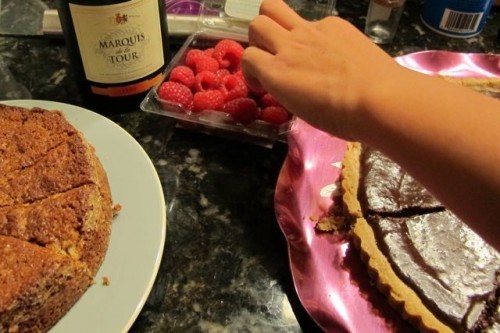
And then dessert: pear cake and bittersweet chocolate tart…with raspberries and champagne for all.
 Chuck Kinder directed the Writing Program at University of Pittsburgh for eight glorious years and is the author of the novels, SNAKEHUNTER (Alfred A. Knopf), THE SILVER GHOST (Harcourt Brace Jovanovich) and HONEYMOONERS: A CAUTIONARY TALE (Farrar, Straus & Giroux), a 2001 New York Times Notable Book, which has been reprinted in Italy (where it became a best-seller), France, Spain, and most recently Israel. HONEYMOONERS was reprinted as a Plume Paperback in 2002, and in June 2009 it was re-issued by the Carnegie Mellon University Press as a part of its Classic Contemporary Series. Kinder's most recent book is a redneck noir, pulp romance meta-memoir titled LAST MOUNTAIN DANCER: HARD EARNED LESSONS IN LOVE, LOSS, AND HONKY-TONK OUTLAW LIFE, which was published in 2004 and reissued in quality-paperback by Carroll & Graf in 2005. It will be reprinted in 2010 by Fazi Editore in Italy. Before Chuck Kinder became a full-fledged fictioneer, whose work reflects his personal philosophy that everything one writes should be as literally true as the Bible, he worked variously as a coal miner, moonshiner, bartender, bouncer, bandit, prize-fighter, circus performer, tango teacher, white-water river guide, professional cook, cowboy, and itinerant college professor. Along the way he received both a BA and MA in English and Creative Writing from West Virginia University, and then entertained two years of graduate study at Stanford University as an Edith Mirrilee's Writing Fellow, whereupon he was appointed to a three-year position as a Jones Lecturer in Fiction at Stanford. He has been a Writer-in-Residence at the University of California at Davis and the University of Alabama in Tuscaloosa. He has lectured at Casa delle Letterature and the Universita La Sopienze in Rome, and the Scuola Holden In Turino, Italy. Kinder's awards include a National Endowment for the Arts Grant in Fiction, a Pennsylvania Council on the Arts Award in Fiction, a Dorothy & Granville Hicks Residence in Literature from the Yaddo Foundation, an Appalachian Heritage Dennis C. Plattner First Place Award for Nonfiction, a W.V.U. 2008 Eberly College of Arts and Sciences Distinguished Alumni Recognition Award, a 2009 University of Pittsburgh Chancellor's Distinguished Teaching Award, and a Most Improved Prisoner of the Month Commendation from the WV Fayette County Christian Jailers Association.
Chuck Kinder directed the Writing Program at University of Pittsburgh for eight glorious years and is the author of the novels, SNAKEHUNTER (Alfred A. Knopf), THE SILVER GHOST (Harcourt Brace Jovanovich) and HONEYMOONERS: A CAUTIONARY TALE (Farrar, Straus & Giroux), a 2001 New York Times Notable Book, which has been reprinted in Italy (where it became a best-seller), France, Spain, and most recently Israel. HONEYMOONERS was reprinted as a Plume Paperback in 2002, and in June 2009 it was re-issued by the Carnegie Mellon University Press as a part of its Classic Contemporary Series. Kinder's most recent book is a redneck noir, pulp romance meta-memoir titled LAST MOUNTAIN DANCER: HARD EARNED LESSONS IN LOVE, LOSS, AND HONKY-TONK OUTLAW LIFE, which was published in 2004 and reissued in quality-paperback by Carroll & Graf in 2005. It will be reprinted in 2010 by Fazi Editore in Italy. Before Chuck Kinder became a full-fledged fictioneer, whose work reflects his personal philosophy that everything one writes should be as literally true as the Bible, he worked variously as a coal miner, moonshiner, bartender, bouncer, bandit, prize-fighter, circus performer, tango teacher, white-water river guide, professional cook, cowboy, and itinerant college professor. Along the way he received both a BA and MA in English and Creative Writing from West Virginia University, and then entertained two years of graduate study at Stanford University as an Edith Mirrilee's Writing Fellow, whereupon he was appointed to a three-year position as a Jones Lecturer in Fiction at Stanford. He has been a Writer-in-Residence at the University of California at Davis and the University of Alabama in Tuscaloosa. He has lectured at Casa delle Letterature and the Universita La Sopienze in Rome, and the Scuola Holden In Turino, Italy. Kinder's awards include a National Endowment for the Arts Grant in Fiction, a Pennsylvania Council on the Arts Award in Fiction, a Dorothy & Granville Hicks Residence in Literature from the Yaddo Foundation, an Appalachian Heritage Dennis C. Plattner First Place Award for Nonfiction, a W.V.U. 2008 Eberly College of Arts and Sciences Distinguished Alumni Recognition Award, a 2009 University of Pittsburgh Chancellor's Distinguished Teaching Award, and a Most Improved Prisoner of the Month Commendation from the WV Fayette County Christian Jailers Association.
Sherrie Flick's Blog
- Sherrie Flick's profile
- 38 followers



